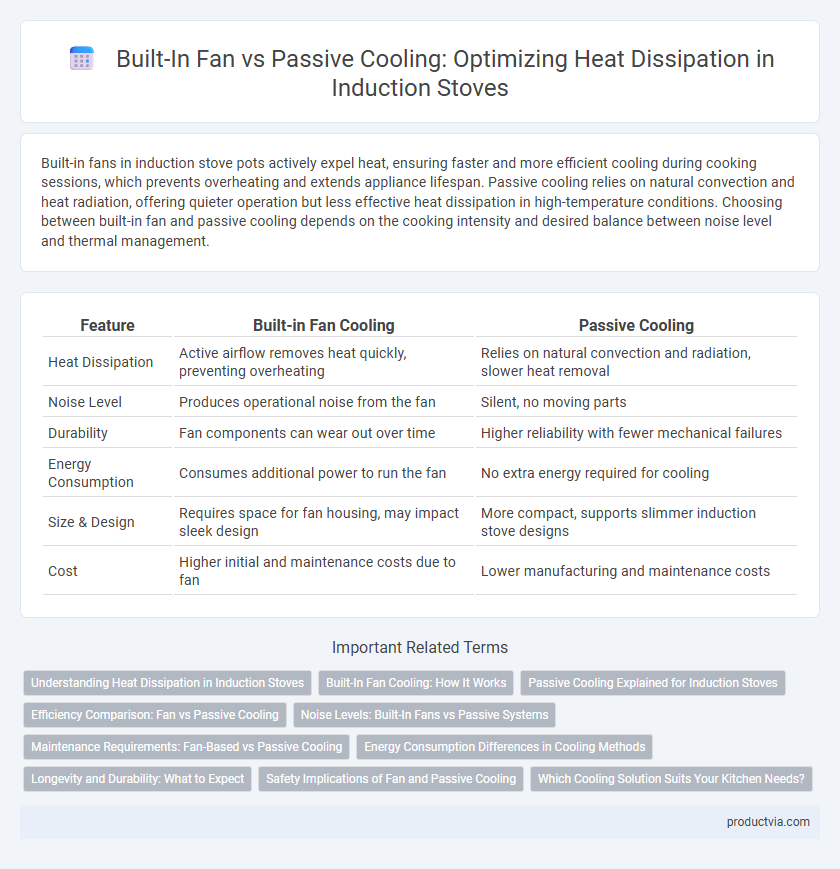Built-in fans in induction stove pots actively expel heat, ensuring faster and more efficient cooling during cooking sessions, which prevents overheating and extends appliance lifespan. Passive cooling relies on natural convection and heat radiation, offering quieter operation but less effective heat dissipation in high-temperature conditions. Choosing between built-in fan and passive cooling depends on the cooking intensity and desired balance between noise level and thermal management.
Table of Comparison
| Feature | Built-in Fan Cooling | Passive Cooling |
|---|---|---|
| Heat Dissipation | Active airflow removes heat quickly, preventing overheating | Relies on natural convection and radiation, slower heat removal |
| Noise Level | Produces operational noise from the fan | Silent, no moving parts |
| Durability | Fan components can wear out over time | Higher reliability with fewer mechanical failures |
| Energy Consumption | Consumes additional power to run the fan | No extra energy required for cooling |
| Size & Design | Requires space for fan housing, may impact sleek design | More compact, supports slimmer induction stove designs |
| Cost | Higher initial and maintenance costs due to fan | Lower manufacturing and maintenance costs |
Understanding Heat Dissipation in Induction Stoves
Induction stoves rely on effective heat dissipation to maintain optimal performance and prevent overheating. Built-in fans actively expel heat by circulating air, significantly enhancing cooling efficiency compared to passive cooling, which relies on natural airflow and heat conduction through materials. Understanding this difference is crucial, as active cooling systems extend the lifespan of induction cooktops and ensure safer, consistent operation during intense cooking sessions.
Built-In Fan Cooling: How It Works
Built-in fan cooling in induction stoves actively dissipates heat by drawing air through vents and directing it over critical components to prevent overheating. This system uses a fan powered by an internal motor, which enhances airflow and maintains optimal operating temperatures, prolonging the lifespan of the electronics. Unlike passive cooling, built-in fans provide more efficient temperature regulation, especially under high power or prolonged usage conditions.
Passive Cooling Explained for Induction Stoves
Passive cooling in induction stoves utilizes natural convection and heat sinks to dissipate heat without relying on mechanical fans, enhancing durability and reducing noise levels. Heat generated during cooking is transferred away through metal components and ventilation slots designed to optimize airflow. This method ensures efficient temperature regulation while maintaining the sleek, compact design favored in modern kitchen appliances.
Efficiency Comparison: Fan vs Passive Cooling
Built-in fan cooling in induction stoves actively expels heat, maintaining lower internal temperatures and preventing overheating during prolonged use, resulting in higher operational efficiency. Passive cooling relies on heat sinks and natural convection, which may be less efficient under heavy loads but offers silent operation and lower energy consumption. Fan cooling systems enable faster heat dissipation, improving performance and durability compared to passive cooling setups.
Noise Levels: Built-In Fans vs Passive Systems
Built-in fans in induction stoves actively dissipate heat, resulting in higher noise levels typically around 40-50 dB, which may be noticeable in quiet kitchen environments. Passive cooling systems rely on heat sinks and convection without moving parts, producing near-silent operation with noise levels close to 0 dB. Users prioritizing noise reduction often prefer passive cooling, whereas built-in fans offer more efficient heat management during intensive cooking sessions.
Maintenance Requirements: Fan-Based vs Passive Cooling
Built-in fan systems in induction stoves require regular maintenance to ensure optimal airflow, including cleaning dust filters and checking fan functionality. Passive cooling mechanisms rely on natural heat dissipation with minimal maintenance, reducing the need for frequent servicing. However, fan-based cooling may extend the lifespan of electronic components by preventing overheating more effectively than passive systems.
Energy Consumption Differences in Cooling Methods
Built-in fans in induction stoves actively dissipate heat by circulating air, resulting in higher energy consumption compared to passive cooling systems that rely on natural convection. Energy efficiency improves with passive cooling as it eliminates power usage for fan operation, reducing overall electricity demand. However, built-in fans provide faster heat removal, which can prolong appliance lifespan despite the increased energy use.
Longevity and Durability: What to Expect
Built-in fan systems in induction stoves actively dissipate heat, significantly enhancing longevity by preventing overheating and ensuring consistent performance under heavy use. Passive cooling relies on natural convection, which may suffice for light cooking but risks higher internal temperatures that can shorten component lifespan. Choosing induction stoves with built-in fans often translates to improved durability and longer operational life due to efficient thermal management.
Safety Implications of Fan and Passive Cooling
Built-in fans in induction stoves actively dissipate heat, reducing the risk of overheating and improving overall safety by maintaining optimal operating temperatures. Passive cooling relies on natural airflow and heat sinks, which may be less efficient and potentially lead to higher internal temperatures, increasing the risk of component failure or fire hazards. Choosing induction stoves with built-in fans enhances safety by providing consistent thermal management and preventing dangerous heat buildup.
Which Cooling Solution Suits Your Kitchen Needs?
Built-in fans in induction stoves actively expel heat, ensuring consistent performance during extended cooking sessions and are ideal for kitchens with limited ventilation. Passive cooling relies on natural airflow and heat sinks, offering silent operation and lower maintenance but may struggle with high thermal loads. Choose built-in fan models for intensive cooking environments or passive cooling for quieter, low-demand kitchen setups.
Built-in fan vs Passive cooling for heat dissipation Infographic

 productvia.com
productvia.com